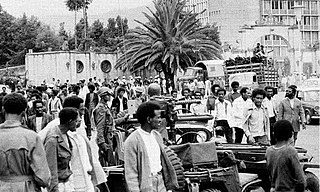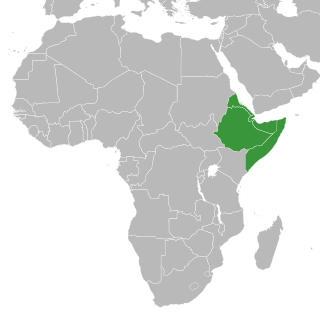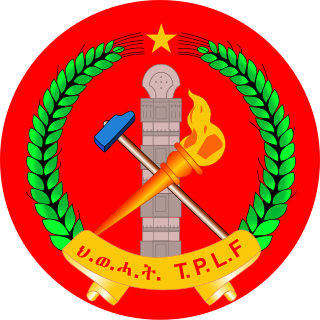The Eritrean War of Independence was fought as a guerrilla campaign by two main Eritrean liberation fronts, first by the Eritrean Liberation Front (ELF) and then, after the Eritrean Civil Wars, by the Eritrean People's Liberation Front (EPLF) against the Ethiopian Empire, and later the Marxist Derg regime . This asymmetrical campaign against Ethiopian control left the Ethiopian military at a disadvantage and so it embarked on a policy of destroying Eritrean villages.[ citation needed ] It was hoped that this would prevent the separatists from continuing their campaign. Listed below are some of the major civilian massacres committed by both the Ethiopian Empire and the Derg.
| Date | Deaths | Location | Description of event |
|---|---|---|---|
| 1967-07-24 | 172 | Hazemo | Several villages wiped out and the throats of men slit in front of their wives and children. [1] [2] |
| Late 1967 | Approx 50 | Akordat | Students suspected of being members of the ELF were hanged in the centre of town. Parents of the slain were forced, by the Ethiopian Army, to unhang their dead children and take them home. [3] |
| 6 August 1970 | Missian | Ethiopian Army entered the village killing all civilians men and burning down the village totally.[ citation needed ] | |
| 1970-01-17 | 60 | Elabared | The village elders were rounded up for supporting the Eritrean Liberation Front and killed. [4] |
| 1970-11-30 | 120 | Besikdira | The entire village was rounded up into the local mosque and the mosque's doors were locked, the building was then razed and survivors were shot. [2] [5] |
| 1970-12-01 | 800+ | Ona | Ethiopian Army units surrounded the village killing civilians and burning down the village. [6] |
| 1974-07-10 | 170+ [2] | Om Hajer | |
| 1974-12-28 | 45 [7] | Asmara | Students were strangled to death using piano strings, their bodies were dumped in alleyways and doorsteps. |
| 1971 | Approx 70 | Keren | Students and youth suspected of supporting the ELF were publicly executed by hanging. Family members were forced to attend the execution and cut down their children from the noose. |
| 1975-02-14 | 3000 [8] [9] | Asmara, Surrounding villages | Shortly after an EPLF attack on two Ethiopian divisions, Ethiopian troops fire upon civilians gathered in Churches, homes and schools. |
| 1975-02-02 | 80 [2] -103 [4] | Wekiduba | During an engagement with the EPLF and ELF the Ethiopian Army attacked the church where villagers had taken refuge. The massacre is known is Eritrea as Black Saturday. [10] |
| 1975-03-09 | 258 [4] | Agordat | After several ELF attacks on the town the Ethiopian Army retaliated on the local population. |
| 1975-04-17 | 235 [2] -470 [11] | Hirgigo | |
| August 1975 | ~250 | Om Hajer | The villagers were machine gunned in front of a river to prevent escape. [4] |
| 1976-12-30 | 105 [9] | Hirgigo | |
| 1985-10-19 | 39 [2] | Mogoraib | |
| April 1988 | 3 | Agordat | Killed by aerial attacks.50 ELF Martyr [12] Eritrea |
| 1988-05-04 | unknown | Shebah [2] | |
| 1988-12-05 | 400+ [13] | She'eb | The dead were mostly women and children as the men had moved to the towns to eke out a living for their impoverished village. [4] |
| 3–4 April 1990 | 67 killed, 125 wounded | Afabet | Aerial attacks [12] |
| 24 April 1990 | 50 killed, 110 wounded | Massawa | Aerial attacks, cluster bombs [14] Throughout the conflict Ethiopia used "anti-personnel gas" [15] |

Isaias Afwerki is an Eritrean politician and partisan who has been the president of Eritrea since shortly after he led the Eritrean People's Liberation Front (EPLF) to victory in 24 May 1991, ending the 30-year-old war for independence from Ethiopia.

The Derg, officially the Provisional Military Administrative Council (PMAC), was the Marxist-Leninist military dictatorship that ruled Ethiopia, then including present-day Eritrea, from 1974 to 1987, when the military leadership or junta formally "civilianized" the administration but stayed in power until 1991.

The Eritrean People's Liberation Front (EPLF), colloquially known as Shabia, was an armed Marxist–Leninist organization that fought for the independence of Eritrea from Ethiopia. It emerged in 1970 as a far-left to left-wing nationalist group that split from the Eritrean Liberation Front (ELF). After achieving Eritrean independence in 1991, it transformed into the People's Front for Democracy and Justice (PFDJ), which serves as Eritrea's sole legal political party.

The Eritrean–Ethiopian War, also known as the Badme War, was a major armed conflict between Ethiopia and Eritrea that took place from May 1998 to June 2000.

The Eritrean War of Independence was a war for independence which Eritrean independence fighters waged against successive Ethiopian governments from 1 September 1961 to 24 May 1991.

Humera is a town in the Kafta Humera woreda in the Tigray Region of Ethiopia. Located in the Western Zone the town has an elevation of 585 metres (1,919 ft) above sea level. The Tekezé river borders the town to the north. Humera is a very important regional agricultural center based on intensive agriculture. It is the last Ethiopian town south of the border with Eritrea and Sudan, and is considered to be a strategically important gateway to Sudan.

The Oromo Liberation Front is an Oromo nationalist political party formed in 1973 to promote self-determination for the Oromo people inhabiting today's Oromia Region and Oromia Zone in the Amhara Region of Ethiopia. The OLF has offices in Addis Ababa, Washington, D.C. and Berlin from where it operates Amharic and Oromo radio stations.

The Ethiopian Civil War was a civil war in Ethiopia and present-day Eritrea, fought between the Ethiopian military junta known as the Derg and Ethiopian-Eritrean anti-government rebels from 12 September 1974 to 28 May 1991.

Conflicts in the Horn of Africa have been occurring since the 17th century BCE. The Horn of Africa includes the nations of Djibouti, Eritrea, Ethiopia, and Somalia and the de facto independent nation of Somaliland.
The Second Battle of Massawa took place in 1990 in and around the coastal city of Massawa in Eritrea. The offensive was conducted by both land and sea units of the Eritrean People's Liberation Front (EPLF) against the Ethiopian Army.

The military history of Ethiopia dates back to the foundation of early Ethiopian Kingdoms in 980 BC. Ethiopia has been involved in many of the major conflicts in the horn of Africa, and was one of the few native African nations which remained independent during the Scramble for Africa, managing to create a modern army. 19th and 20th century Ethiopian Military history is characterized by conflicts with the Dervish State, Mahdist Sudan, Egypt, and Italy, and later by a civil war.
Sheraro is a town and separate woreda in Tigray, Ethiopia. It is located in the North Western Zone of the Tigray Region, at an elevation of 1246 meters above sea level. It is the administrative center of Tahtay Adiyabo. It is near the border with Eritrea.

The Oromo conflict is a protracted conflict between the Oromo Liberation Front (OLF) and the Ethiopian government. The Oromo Liberation Front formed to fight the Ethiopian Empire to liberate the Oromo people and establish an independent state of Oromia. The conflict began in 1973, when Oromo nationalists established the OLF and its armed wing, the Oromo Liberation Army (OLA). These groups formed in response to prejudice against the Oromo people during the Haile Selassie and Derg era, when their language was banned from public administration, courts, church and schools, and the stereotype of Oromo people as a hindrance to expanding Ethiopian national identity.
The following is a timeline of the history of the city of Asmara, Eritrea. Asmara was under Italian colonial rule from 1889 until 1941.

Tigrayan nationalism is an ethnic nationalism that advocates the interests of Tigrayan people in Ethiopia. Inspired predominantly by the Tigray People's Liberation Front (TPLF) with its predecessor Tigray Liberation Front (TLF), this type of nationalism holds that Tigrayans are an independent group with unique ancestry, heritage, history and culture outside Ethiopia. As such, they claim Tigray is the source of Ethiopian civilization and utterly a benefactor of state-building without other local ethnic groups. Tigrayan nationalist accuse Amhara imperial dominance of oppressing their identity despite the fact that both Amhara and Tigray emperors have contributed to the creation of modern Ethiopia.

The fall of the Derg, also known as Downfall of the Derg, was a military campaign that resulted the defeat of the ruling military junta Derg by the rebel coalition Ethiopian People's Revolutionary Democratic Front (EPRDF) on 28 May 1991 in Addis Ababa, ending the Ethiopian Civil War. The Derg took power after deposing Emperor Haile Selassie and the Solomonic dynasty, an imperial dynasty of Ethiopia that began in 1270. The Derg suffered insurgency with different factions, and separatist rebels groups since early their rule, beginning with the Ethiopian Civil War. The 1983–1985 famine, the Red Terror, and resettlement and villagization infamed the Derg with majority of Ethiopians tended to support insurgent groups like the Tigray People's Liberation Front (TPLF) and Eritrean People's Liberation Front (EPLF).
The 1995 Ethiopian Federal Constitution formalizes an ethnic federalism law aimed at undermining long-standing ethnic imperial rule, reducing ethnic tensions, promoting regional autonomy, and upholding unqualified rights to self-determination and secession in a state with more than 80 different ethnic groups. But the constitution is divisive, both among Ethiopian nationalists who believe it undermines centralized authority and fuels interethnic conflict, and among ethnic federalists who fear that the development of its vague components could lead to authoritarian centralization or even the maintenance of minority ethnic hegemony. Parliamentary elections since 1995 have taken place every five years since enactment. All but one of these have resulted in government by members of the Ethiopian People's Revolutionary Democratic Front (EPRDF) political coalition, under three prime ministers. The EPRDF was under the effective control of the Tigray People's Liberation Front (TPLF), which represents a small ethnic minority. In 2019 the EPRDF, under Abiy, was dissolved and he inaugurated the pan-ethnic Prosperity Party which won the 2021 Ethiopian Election, returning him as prime minister. But both political entities were different kinds of responses to the ongoing tension between constitutional ethnic federalism and the Ethiopian state's authority. Over the same period, and all administrations, a range of major conflicts with ethnic roots have occurred or continued, and the press and availability of information have been controlled. There has also been dramatic economic growth and liberalization, which has itself been attributed to, and used to justify, authoritarian state policy.

Since the start of Tigray War in November 2020, the Eritrean government has been heavily involved in the war against the Tigray People's Liberation Front (TPLF) in support of the Ethiopian government.
{{cite journal}}: Cite journal requires |journal= (help)